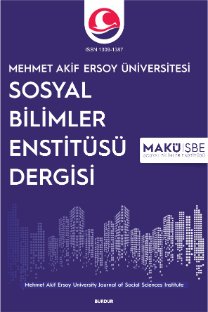İŞ YERİNDE MİZAH: BANKA ÇALIŞANLARININ METAFORİK ALGILARI
İş Yerinde Mizah, Banka Çalışanları, Metafor, Metafor Kuramları, Nitel Araştırma
HUMOR AT WORK: BANK EMPLOYEES METAPHORICAL PERCEPTION
Humor at Work, Bank Employees, Metaphor, Humor Theories, Qualitative Research,
___
- Abalı, İ. (2016). Mizah teorileri bağlamında yörük fıkraları, Motif Akademi Halk Bilimi Dergisi, 9 (17), 113-132.
- Arastaman, G., Öztürk Fidan, İ. ve Fidan, T. Nitel araştırmada geçerlik ve güvenirlik: Kuramsal bir inceleme, YYÜ Eğitim Fakültesi Dergisi (YYU Journal of Education Faculty), 15(1):37-75,
- Ayduğ, D., Himmetoğlu, B. ve Bayrak, C. (2018). Okul müdürlerinin mizah tarzlarına ilişkin öğretmenlerin metaforik algıları. Eğitimde Nitel Araştırmalar Dergisi – Journal of Qualitative Research in Education, 6(2), 108-130. DOI:10.14689/issn.2148 - 2624.1.6c2 s6m
- Chan, S. C. (2010). Does workplace fun matter? Developing a useable typology of workplace fun in a qualitative study. International Journal of Hospitality Management, 29, 720-728. http://dx.doi.org/10.1016/j.ijhm.2010.03.001
- Cooper, C. (2008) Elucidating the bonds of workplace humor: A relational process model. Human Relations, 61, 1087-1115.
- Creswell, J.W. (2018) Nitel Araştırma Yöntemleri Beş Yaklaşıma Göre Nitel Araştırma ve Nitel Araştırma Deseni (4. Baskı). (M. Bütün ve S.B. Demir Çev.). Ankara: Siyasal Kitabevi
- Davis, A. ve Kleiner, B. H. (1989). The value of humor in effective leadership. Leadership Organizational Development Journal,10, 1-3.
- Decker, W. H., ve Rotondo, D. M. (2001). Relationships among gender, type of humor, and perceived leader effectiveness, Journal of Managerial Issues, 13(4), 450–465.
- Duncan, W.J. (1985) The superiority theory of humor at work: Joking relationships as indicatorsof formal and informal status patterns in small, task-oriented groups. Small Group Behavior, 16(4), 556–64.
- Ekici, G. (2016). Biyoloji öğretmeni adaylarının mikroskop kavramına ilişkin algılarının belirlenmesi: Bir metafor analizi çalışması, Ahi Evran Üniversitesi Kırşehir Eğitim Fakültesi Dergisi (KEFAD) 17 (1), 615-636.
- Göçer, A. (2013). Türkçe öğretmeni adaylarının kültür dil ilişkisine yönelik metaforik algıları. Turkish Studies - International Periodical for the Languages, Literature and History of Turkish or Turkic, 8(9), 253-263.
- Guba, E. G. (1981). Criteria for assessing the trustworthiness of naturalistic inquiries. Educational Technology Research And Development, 29(2), 75-91.
- Hasırcı, S. (2017). Türkçe öğretmeni adaylarının çocuk edebiyatına ilişkin algılarının metaforlar aracılığıyla analizi, Uluslararası Sosyal Araştırmalar Dergisi The Journal of International Social Research, 10(51), 717- 728. http://dx.doi.org/10.17719/jisr.2017.1808
- Iqball, Q. ve Hassan, S.H. (2018). A dyadic analysis of salespersons and customers in banking sector: Humor usage, word of mouth and expectation of continuity, International Academic Journal of Business Management, 5 (3), 109-120.
- Javadi, M.H.M, Salehzadeh, R. ve Poor, S.H. (2013). Studying the relationship between umor and organizational citizenship behavior, International Journal of Academic Research in Accounting, Finance and Management Sciences, 3 (3), 146-151, http://dx.doi.org/10.6007/IJARAFMS/v3-i3/100
- Lennon-Maslin, M. (2018), Comic relief: Examining the protective effects of coping humour on burnout in human, Yayınlanmamış Yüksek Lisans Tezi, Dublin İşletmecilik Okulu, Dublin
- Lincoln, Y. S. ve Guba, E. G. (1986). But is it rigorous? Trustworthiness and authenticity in naturalistic evaluation. New Directions For Evaluation, (30), 73-84.
- Liu, Y. Z. ve Wang, L. Q. (2016). A review of organization humor: Concept, measurement and empirical research. Psychology, 7, 1307-1314. http://dx.doi.org/10.4236/psych.2016.710132
- Martin, R. A. (2010). The Psychology of Humor: An Integrative Approach.Elsevier Academic Press.
- Mesmer-Magnus, J., Glew, D. J. ve Viswesvaran, C. (2012), A meta-analysis of positive humor in the workplace, Journal of Managerial Psychology, 27 (2), 155 – 190, http://dx.doi.org/10.1108/02683941211199554
- Meyer, J. (2000) Humor as a double-edged sword: Four functions of humor in communication. Communication Theory, 10 (3), 310-33.
- Mıles, M.B. ve Huberman, M.A. (1994). Qualitative Data Analysis: An Expanded Sourcebook (2. baskı), California: Sage Publications.
- Miller, J., (1996) Humor: an empowerment tool for the 1990’s, Empowerment in Organizations, 4(2), 16-21.
- Miznikova , J. ve Schönfeldt, S.N. (2010). The Serious Business of Humor - A qualitative study of humor as a management tool, Yayınlanmamış Yüksek Lisans Tezi, Umeå İşletme Okulu, İsveç.
- Oktuğ, Z., Turgut, T. ve Ünal, Z.M. (2018). İşyerinde mizah yoluyla başa çıkma ölçeği: Türkçe’ye uyarlanması, güvenilirlik ve geçerlilik çalışması, Mehmet Akif Ersoy Üniversitesi Sosyal Bilimler Enstitüsü Dergisi, 10 (26), 782-797.
- Opthani, H.S.A., Omar, R. ve Bakri, N. (2013). A Qualitative Approach for investigating the adopted styles of humor in the Omani Public sector, Arabian Journal of Business and Management Review, 2 (6), 194-206.
- Peebles, D. (2015). The value of positive humour in the workplace, Yayınlanmamış Doktora Tezi, Tasmanya Üniversitesi.
- Plester, B. (2009). Healthy humour: Using humour to cope at work, Kotuitui: New Zealand Journal of Social Sciences Online, Vol. 4 (1), 89-102, https://doi.org/10.1080/1177083X.2009.9522446
- Romero, E.J. ve Cruthirds, K. (2006) The use of humor in the workplace, Academy of Management Perspectives, 20, 58–69.
- Rüzgar, N. (2018), Çalışanların insan kaynakları yönetimi modelleri ile yöneticilerinin mizah tarzlarına ilişkin algılarının iş tatminleri üzerindeki etkisinin incelenmesi, Yayınlanmamış Doktora Tezi, İstanbul Ticaret Üniversitesi.
- Sığrı, Ü. (2018). Nitel araştırma yöntemleri (1. Baskı). İstanbul: Beta Basım Yayın Dağıtım A.Ş.
- Warren, S. ve Fineman, S. (2006). ‘Don't get me wrong, it's fun here, but …’: ambivalence and paradox in a ‘fun’ work environment. R Westwood ve C Rhodes (Ed.), Humour Work and Organization içinde (92-112). Routledge, Abingdon, U.K., https://doi.org/10.4324/9780203390191
- Yam, K.C., Christian, M.S., Wei, W., Liao, Z. ve Nai, J. The mixed blessing of leader sense of humor: Examining costs and benefits. (2018). Academy of Management Journal. 61, (1), 348 369.
- Yayın Aralığı: 4
- Başlangıç: 2009
- Yayıncı: Burdur Mehmet Akif Ersoy Üniversitesi Sosyal Bilimler Enstitüsü
DOĞRUDAN YABANCI YATIRIMLARIN TÜRKİYE’NİN İHRACAT ÜRÜN ÇEŞİTLİLİĞİ ÜZERİNE ETKİSİ
Gürkan CUNDA, Selim Adem HATIRLI
MAHALLEYE DÖNÜŞEN KÖYLER ÜZERİNE BİR İNCELEME
LIVIUS ANDRONICUS VE LATİN EDEBİYATI’NDAKİ YERİ VE ÖNEMİ
İŞVEREN MARKASI ALGISININ ETKİLİ LİDERLİK İLE İLİŞKİSİ VE BİR ARAŞTIRMA
Bünyamin AKDEMİR, Emine KARAKAPLAN ÖZER
ENDÜSTRİ 4.0 TÜRKİYE FARKINDALIĞI
Eren KAMBER, Gülin İdil SÖNMEZTÜRK BOLATAN
ÇALIŞAN MUTLULUĞUNUN VE İŞE BAĞLILIĞIN ÖRGÜT PERFORMANSINA ETKİSİ
Aysun YEŞİLTAŞ, Sibel ŞAHİN, Gözde SEREZLİ
Hasan BÜLBÜL, Arzum BÜYÜKKEKLİK, Buket ÖZOĞLU
FEN BİLGİSİ ÖĞRETMEN ADAYLARININ BİLİM İNSANLARINA YÖNELİK GENEL BİLGİ DÜZEYLERİNİN BELİRLENMESİ
